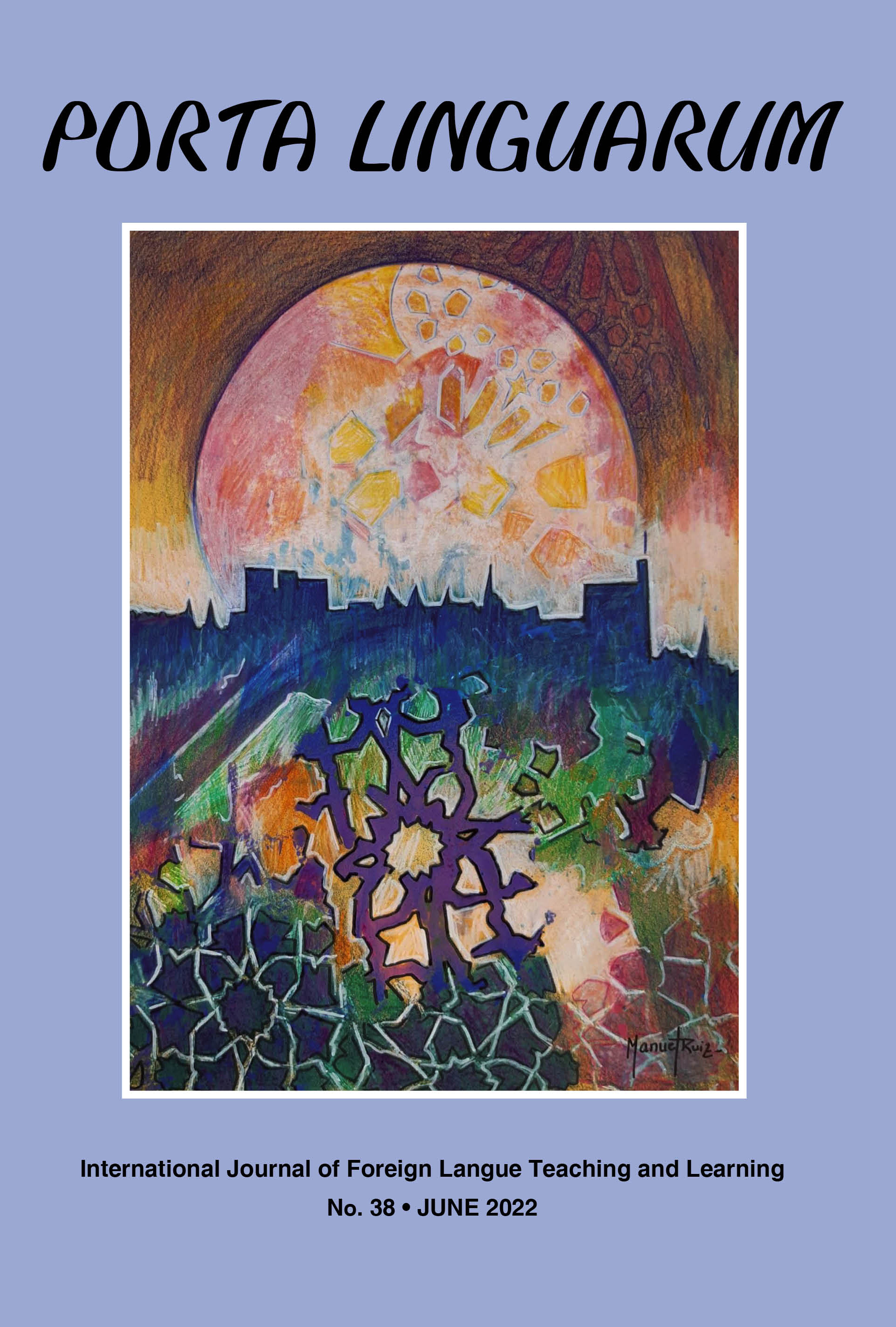New genres and new approaches: teaching and assessing product pitches from a multimodal perspective in the ESP classroom
DOI:
https://doi.org/10.30827/portalin.vi38.21621Palabras clave:
Product Pitch (PP), percepción de la multimodalidad, valuación multimodal, apoyo,, apoyo, ciclo de enseñanza-aprendizajeResumen
Uno de los géneros más innovadores de la comunicación empresarial actual es el denominado “Product Pitch” (PP), caracterizado sobre todo por su naturaleza multisemiótica (Daly & Davy, 2016), que precisa un enfoque multimodal para su análisis y enseñanza (Tamarit &S korczynska, 2014; Valeiras-Jurado, 2017). Sin embargo, es escasa la investigación sobre la enseñanza de los PPs a estudiantes de inglés empresarial. El objetivo de este artículo es presentar un modelo pedagógico innovador basado en el estudio del género y dirigido por el propio aprendiz que se desarrolla en torno a un ciclo de enseñanza y aprendizaje que promueve el pensamiento crítico y la percepción de la multimodalidad (Querol-Julián & Fortanet-Gómez, 2019). Siguiendo las cuatro etapas del ciclo propuesto y con la ayuda constante del profesor, un grupo de estudiantes de negocios decodificó las agrupaciones multimodales de un PP de YouTube para posteriormente crear sus propios PP, que fueron evaluados desde el punto de vista multimodal por el resto de la clase (evaluación por pares) y por la profesora utilizando una rúbrica que incluye todos los modos.
Descargas
Citas
Archer, A. (2010). Multimodal texts in higher education and the implications for writing pedagogy. English in Education, 44(3), 201-213.
Campoy-Cubillo, M.C. & Querol-Julián, M. (2015). Assessing multimodal listening. In B. Crawford & I. Fortanet-Gómez (eds.). Multimodal analysis in academic settings: From research to teaching. Routledge.
Canale, M., & Swain, M. (1980). Theoretical bases of communicative approaches to second language teaching and testing. Applied Linguistics, 1: 1-47.
Cestero-Mancera, A. (2017). La comunicación no verbal en discurso persuasivo empresarial. Pragmalingüística, 25, 124-145.
Council of Europe (2001). Common European framework of reference for languages. https://rm.coe.int/1680459f97 (Retrieved 10 May 2021)
Cope, B. &Kalantzis, M. (2009). Multiliteracies: New literacies, new learning.
Pedagogies: An International Journal, 4, 164-195.
Daly, P. & Davy, D. (2016). Structural, linguistic and rhetorical features of the entrepreneurial pitch: lessons from Dragons’ Den. The Journal of Management Development, 35(1), 120-132.
Ducasse, A. M. (2020) Evidence-based persuasion: a cross-cultural analysis of entrepreneurial pitch in english and in Spanish. Journal of International Entrepreneurship, 18, 492-510.
Ford, M.J. & Forman, E.A. (2006). Redefining disciplinary learning in classroom contexts. Review of Research in Education 30, 1-32.
Fortanet-Gómez, I & Bernad-Mechó, E. (Eds.) (2019). Multimodal analysis of specialized discourse. Special Issue. Ibérica, 37: 9-15.
Jiménez-Muñoz, A. (2019). Beyond language: a multimodal analysis of success in non-native business english pitches. Ibérica 37, 65-86.
Kress, G. (2011) Partnerships in research: multimodality and ethnography. Qualitative research, 11(3), 239-260.
Martin, J. R. (1999). Mentoring semogenesis: ‘Genre-based’ literacy pedagogy. In F.Christie (Ed.), Pedagogy and the shaping of consciousness. Linguistic and social processes (pp. 123-155). London/ New York: Continuum.
Martin, J.R. & Rose, D. 2005. Designing literacy pedagogy: scaffolding democracy in the classroom. In Hasan, R., Matthiessen, C.M.I.M. and Webster, J. (Eds). Continuing discourse on language. Equinox.
Martin, J.R. & Rose, D. (2008). Genre relations: Mapping culture. Equinox.
Martin, J. R. (2009). Genre and language learning: A social semiotic perspective. Linguistics and Education, 20, 10-21.
Morell, T. (2015). International conference paper presentations: A multimodal analysis to determine effectiveness. English for Specific Purposes, 37, 137–150.
Morton, T. (2010). Using a genre-based approach to integrating content and language in CLIL. The example of secondary history. In C. Dalton-Puffer, T. Nikula, & U. Smit (Eds.) Language use and language learning in CLIL classrooms (pp. 81-104). John Benjamins.
Norris, S. (2004). Analyzing multimodal interaction: A methodological framework. Routledge.
O’Halloran, K., Tang, S., & Smith, B. A. (2015). Multimodal approaches to English for academic purposes. In K. Hyland & Ph. Shaw (Eds.), The Routledge handbook of English for academic purposes (pp. 256-269). Routledge.
Prior, P. (2014) Multimodality and ESP research. In B. Paltridge & S. Starfield (Eds.) The handbook of English for specific purposes. Wiley Blackwell.
Querol-Julián, M. & Fortanet-Gómez, I. (2019) Collaborative teaching and learning of interactive multimodal spoken academic genres for doctoral students. International Journal of English Studies, 19 (2), 61-82.
Rothery, J. (1996). Making changes: Developing educational linguistics. In R. Hasan & G. Williams (Eds.), Literacy in Society (pp. 86–123). Longman.
Ruiz-Madrid, N. & Valeiras-Jurado, J. (2020). Developing multimodal communicative competence in emerging academic and professional genres. International Journal of English Studies, 20(1), 27-50.
Tamarit, I. & Skorczynska,H. (2014). Argumentative strategies and multimodality in oral business discourse: From theory to practice. Procedia: Social and Behavioral Sciences, 116, 2330-2337.
Valeiras-Jurado, J. (2017). A multimodal approach to persuasion in oral presentations. The case of conference presentations, research dissemination talks and product pitches. PhD Dissertation. University of Ghent.
Valeiras-Jurado, J., Ruiz-Madrid, N., & Jacobs, G. (2018) Revisiting persuasion in oral academic and professional genres. Towards a methodological framework for multimodal discourse analysis of research dissemination talks. Iberica, 35, 93-118.
Viney, R.A.E., Clarke, J., & Cornelissen, J; (2017) Making meaning from multimodality: embodied communication in a business pitch setting. In C. Cassell, A.L. Cunliffe, & G. Grandy (Eds.) The SAGE handbook of qualitative business and management research methods: Methods and challenges. (pp. 298-312). SAGE.
APPENDICES
Due to space limitations, appendices are provided in the complementary webpage https://teachingandassessing.estudio9.net/



















